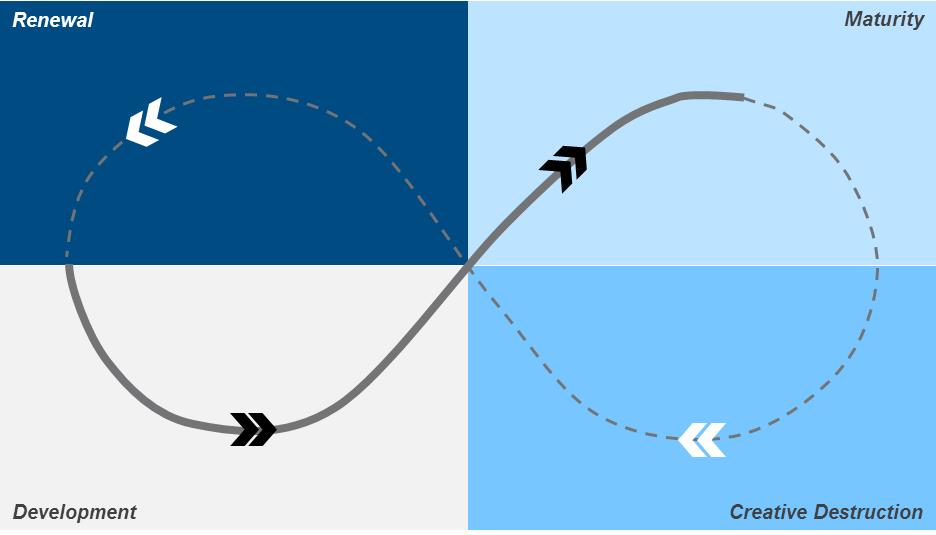This post is a part of our systems thinking tools blog series where we’re introducing and sharing guidance for using different tools to support systems thinking and practice.
The concept of an ecocycle borrows from biological research on how complex natural systems (e.g., forests) survive and thrive in the face of constant ecological change. This research indicates that healthy natural systems continuously move through a closed loop cycle of development, maturity, destruction, and renewal. When applied to organizational strategy and evaluation, the ecocycle model suggests that periodic, natural processes of change within an organization—including experimentation with new ideas and exiting existing efforts—are critical to success and long-term sustainability.
The framework below is a visual depiction of the different phases of the ecocycle. Ecocycle mapping is the process of plotting an organization’s (or coalition’s) various programs, initiatives, and efforts onto the ecocycle framework in order to visualize how resources and energy are distributed across the different phases of ecocycle. We find this concept has a high degree of value for funders with a broad portfolio of grantees or programs, as well as for large organizations (e.g., national nonprofits) and complicated initiatives (e.g., collective impact efforts).

While the visual output of this process can be very helpful from a communications perspective, the experience of reflecting on and discussing where various programs sit on the ecocycle is often the most valuable part of the exercise for participants. The process encourages leaders to view their work from a different perspective, and raises important strategic questions.
Download the “Guide to Ecocycle Mapping” >
Minnesota Philanthropy Partners, a statewide network of charitable affiliates including The Saint Paul Foundation and the Minnesota Community Foundation, hired FSG last year to assist in refining and implementing the organization’s new strategic plan. We used ecocycle mapping to help the organizations reflect on their portfolio of grant programs, initiatives, and emerging partnerships in light of newly articulated values and objectives. Using the tool, staff quickly realized that program officers and organizational leaders spent the majority of their time managing activities and initiatives within the “Reframe or Exit” phase of the ecocycle. Notably, one grant program represented a substantial portion of the effort. While all recognized that reframing this program was a high priority, seeing the portfolio through this lens helped clarify where staff hoped to refocus time, attention, and energy to align internal resources with impact objectives.
The results of the ecocycle mapping exercise helped identify several additional strategic questions, such as:
- What would the ideal distribution of time, energy, and resources across the ecocycle look like? What might need to change internally to achieve this balance?
- Is Minnesota Philanthropy Partners’ pipeline of new opportunities strong enough? What will it take to strengthen the pipeline? Should the organization shift more time and energy to idea sourcing?
- How well is the organization doing at identifying promising ideas and growing them into new grantmaking initiatives or programs?
- What does it mean to revisit and reframe existing activities or initiatives that represent the majority of the organization’s focus? What degree of change is desired? How can the organization responsibility exit from initiatives or programs that are less aligned with its strategic objectives?
The process of ecocycle mapping
Step 1: Framing the activity
One of our first steps in facilitating the ecocycle mapping session was to restructure the framework to use language that felt more natural to the organization.
Step 2: Plotting
In step 2, we brought together a cross-section of Minnesota Philanthropy Partners’ staff and led them through a process of identifying their current and emerging grant programs, initiatives, and partnerships and mapping each effort to its current phase in the ecocycle.
Step 3: Analyzing
Groups can use the visual data provided in Step 2 to inform at least 2 different types of analysis:
Participants can reflect on the spatial distribution of their programs, initiatives, and activities to diagnose where the organization may be experiencing blockages, challenges, or “traps” and where they may want to shift focus in order to cultivate growth and change. (Refer to p. 4 of the attached toolkit for more information on this process.)
Participants can also use these data to better understand how organizational resources are allocated across the cycle and how this compares with the perceived growth and impact of different programs, initiatives, or activities.
As illustrated below, Minnesota Philanthropy Partners focused on the 2nd analytical exercise, which revealed a significant imbalance in the allocation of time and energy across the ecocycle.
Step 4: Reflection and Discussion
Based on the insights generated in Step 3, Minnesota Philanthropy Partners’ staff identified several key questions regarding the use of staff time, energy, and resources that they integrated into their strategic planning process.
Has your organization experimented with ecocycle mapping? If so, we’d love to hear your story. Please share your thoughts in the comments section below.
Download the “Guide to Ecocycle Mapping” >
Descriptions of the ecocycle framework throughout this guide are excerpted and lightly adapted from: Hurst, David K and Brenda Zimmerman. “From Life Cycle to Ecocycle: A New Perspective on the Growth, Maturity, Destruction, and Renewal of Complex Systems.” Journal of Management Inquiry December 1994 3: 339-354.
